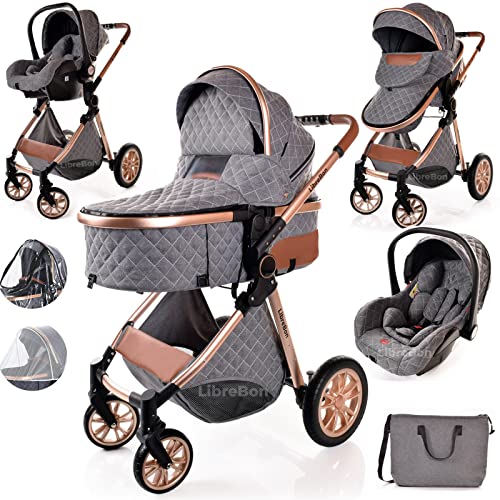Understanding Prams and Pushchairs: A Comprehensive Guide for Parents
When it comes to choosing the ideal mode of transportation for kids, moms and dads are typically overwhelmed by the variety of options available. Prams and pushchairs are among the most common options, and each has its own unique functions dealing with various requirements. This article dives deep into the world of prams and pushchairs, detailing their distinctions, benefits, drawbacks, and pointers for choosing the right one for your family.
What is the Difference Between a Pram and a Pushchair?
Initially look, prams and pushchairs might appear similar, however they serve different functions based on a child's age and developmental phase. Below are the primary differences:
| Feature | Pram | Pushchair |
|---|---|---|
| Age Range | Normally for newborns as much as 6 months | Appropriate for children 6 months and older |
| Style | Flat, horizontal lying position for newborns | Upright seating position; more flexible and mobile |
| Usage | Mostly for strolling with babies | May include several seating choices and setups |
| Foldability | Typically bulkier and less portable | Normally lightweight and foldable for easy transportation |
Kinds of Prams and Pushchairs
Selecting the right pram or pushchair can depend upon different elements, consisting of the type, functions, and way of life of the household. Below are the main kinds of prams and pushchairs available in the market:
Prams
- Standard Prams: Designed for newborns, they typically feature a deep and comfortable bassinet, making them ideal for young babies.
- Travel System Prams: These can shift from a bassinet to a young child seat, often consisting of a baby safety seat for ease of travel.
Pushchairs
- Requirement Pushchairs: Offer an upright seat and are ideal for older babies and young children. They often feature reclining abilities.
- Umbrella Pushchairs: Lightweight and extremely portable, these designs fold compactly, making them perfect for travel.
- All-Terrain Pushchairs: Designed for rugged landscapes, they feature bigger wheels and exceptional suspension systems for off-road abilities.
Benefits and Disadvantages
Benefits of Prams
- Comfort for Newborns: Their flat, horizontal style is ideal for the healthy back development of babies.
- Stylish Designs: Many prams featured classy aesthetics, interesting fashion-forward moms and dads.
- Roomy: They tend to use a larger space for infants to move easily.
Downsides of Prams
- Bulkiness: They can be heavy and difficult to steer, making them less practical for public transportation or crowded areas.
- Cost: Prams usually feature a greater price tag compared to pushchairs.
Advantages of Pushchairs
- Portability: Many pushchairs fold compactly and are lightweight, providing impressive convenience for parents on the go.
- Versatility: With several setups available, pushchairs can match numerous stages of a child's development.
- Simpler to Store: Their smaller size makes them simpler to keep in compact spaces.
Downsides of Pushchairs
- Less Comfort for Newborns: Most standard pushchairs disagree for really young babies unless designed with a reclining function.
- Resilience Concerns: Budget pushchairs might not withstand extensive usage compared to stronger pram models.
Tips for Choosing the Right Pram or Pushchair
Choosing the best pram or pushchair requires cautious consideration. Here are some important factors to bear in mind:
- Age Appropriateness: Consider your kid's age. visit the following internet page might be preferable for a newborn, while a pushchair might be chosen for an older kid.
Way of life Compatibility:
- If you frequently travel or use public transportation, a lightweight choice might be more convenient.
- For active families who delight in outdoor activities, a sturdy, all-terrain pushchair could be helpful.
Storage Needs:
- Think about where you'll keep the pram or pushchair, as some models can take up substantial space.
- Budget Constraints: Prams can be expensive, specifically designer models. Identify features that are most important to you before buying.
- Safety Features: Always look for necessary safety functions like straps, brakes, and durability when choosing a pram or pushchair.
Frequently asked questions
1. At what age can my baby begin utilizing a pushchair?
The majority of pushchairs appropriate for babies from 6 months, however some convertible designs can safely accommodate more youthful infants when utilized with an automobile seat or bassinet accessory.
2. Can I take a pram or pushchair on public transport?
The majority of public transport systems accommodate prams and pushchairs, but it's sensible to examine particular policy standards ahead of time.
3. How can I preserve my pram or pushchair?
Routine cleaning, looking for wear and tear, and lubing moving parts will help in keeping your pram or pushchair's performance and durability.
4. Are travel systems worth the investment?
Travel systems can be a terrific financial investment for parents who often travel, offering an all-in-one service from vehicle to stroller. They provide benefit and ease of shift, specifically for new parents.
5. Are there prams and pushchairs with extra features?
Yes, many contemporary designs feature features like cup holders, storage baskets, adjustable deals with, canopies for sun shading, and even folding mechanisms that can be operated with one hand.
Choosing in between a pram and a pushchair is a choice that impacts daily parenting regimens. By understanding the distinctions, advantages, and appropriate choices, households can make educated options that harmonize with their lifestyle needs. Whether it's a leisurely stroll in the park with a pram or a daring outing with an all-terrain pushchair, the very best options frequently lead to valued memories and satisfying experiences for both parents and children.

